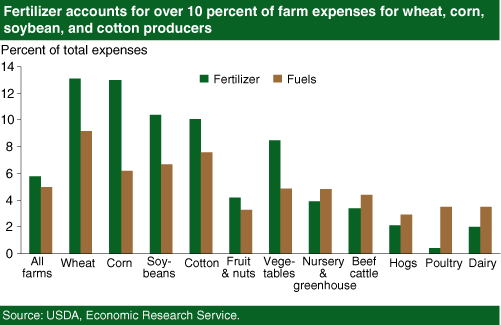Farm Operators Turn to Energy-Saving Practices
- by Dennis Brown, Christopher McGath and Peter L. Stenberg
- 4/1/2008
Over the past 5 years, the price of fuels has risen sharply and remains high by historical standards. Driven by strong worldwide economic growth (especially in China and India) and other factors, the inflation-adjusted price per barrel of crude oil (refiner average acquisition cost) climbed 145 percent since 2002. Over the same period, the inflation-adjusted price of (wellhead) natural gas, a major ingredient in the production of fertilizer, rose 93 percent.
Higher energy prices have resulted in higher onfarm energy expenses, with annual average real prices paid for diesel, gasoline/gasohol, and liquefied petroleum (LP) gas increasing 61 percent since 2002. But even with relatively large increases in prices and expenditures for fuels and fertilizers in recent years, these items account for a relatively small share of farm production expenses—5 percent for fuels and oils and 6 percent for fertilizers in 2007. Fuel and fertilizer use, however, varies significantly among different farm types. Compared with total farm production expenses, costs of these inputs tend to be highest for wheat, corn, soybean, and cotton producers.
Some farmers have been able to reduce the effect of higher energy prices by employing more energy-efficient farming practices (although operators have been using such strategies for many years). According to the 2006 Agricultural Resource Management Survey (ARMS), 524,000 operators—representing about a quarter of all farmers—took some action to reduce fuel or fertilizer expenses in 2006. The most common practices to lower fuel expenses were to regularly service engines and reduce the number of trips over fields.
Cutting back on the quantity of fertilizer applied was the most common practice employed to reduce fertilizer expenses. Other actions included conducting soil tests (to determine an efficient mix of fertilizer use) and negotiating price discounts.
Rising energy prices and government policy have also encouraged some farmers to participate in alternative energy markets. According to ARMS data for 2006, nearly 4,000 farm operators produced crops solely for energy purposes and about half of these farmers operated commercial farms (farms with sales of at least $250,000). ARMS data also indicate that about 14,000 operators in 2006 earned dividends from firms that produced ethanol. Farmers earning dividends from ethanol tended to be older and wealthier, with about half at least 65 years of age, while 85 percent lived in households with high income/high wealth (relative to the national median).
This article is drawn from:
- Agricultural Income and Finance Outlook. (2007). USDA, Economic Research Service.
We’d welcome your feedback!
Would you be willing to answer a few quick questions about your experience?


